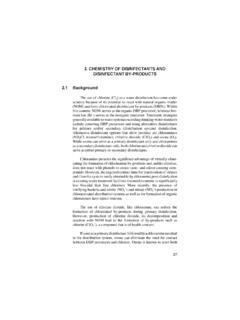Transcription of LANTEC Visit us on the World Wide Web!
1 LANTEC Visit us on the World Wide Web! H2S ( hydrogen sulfide Sewer Gas) Odor Control Wet Scrubber Design and Chemical Consumption Using Q-PAC Background Sewer gas, chemical name hydrogen sulfide , H2S, is a common source of odor complaints around waste water treatment plants. At low concentrations of 10 ~ 50 ppmv it is source of rotten egg odors associated with treatment plants. It has a very low odor threshhold of ppmv. hydrogen sulfide is also dangerous, at 100 ppmv loss of eyesight will occur and at 300 ppmv the gas is at lethal concentration. And in addition to being a nusciance at low concentrations and dangerous at higher concentration, exposure to H2S between 50 100 ppmv can not be detected by smell as at this concentration level it causes one s olfactory organs in the nose to fail.
2 H2S Control Traditional Wet Scrubbing using Chemicals The most common method of control of H2S gas is to pass the smelly gas through a vertical, packed bed wet scrubber. The air passes up the tower as the scrubbing liquid containing caustic (NaOH) and oxidizing agent (most often bleach or NaOCl, sodium hypochlorite) flows down the tower in counter-current fashion. The high pH provided by the caustic drives the mass transfer from gas to liquid phase by solubolizing H2S as HS- bisulfide and S-2 sulfide ions. Once in solution, the reaction between hydrogen sulfide and oxidzing agent is almost instantaneous (assuming sufficient oxidizing agent is present). This reaction converts the sulfide to sulfate (SO4-2) ion. The overall chemical reaction is described by the following equation: H2S + 4 NaOCl + 2 NaOH Na2SO4 + 4 NaCl + 2H2O Therefore, theoretically, for each molecule of H2S destroyed, four molecules of bleach and two molecules of caustic are consumed.
3 However, the chemistry is not quite so simple, as partial oxidation of H2S also takes place which forms elemental sulfur: H2S + NaOCl NaCl + H2O + S This reaction represents about 1% of the chemistry present in a wet scrubber. The presence of excess bleach helps to minimize the formation of elmental sulfur. But bleach is an expensive chemical. The use of two stage scrubbing is often employed both to minimize chemcial consumption as well as to control sulfur deposits when scrubbing H2S. The first stage operates at~ 80% efficiency and uses a caustic only scrub at high pH (~ ). The air then passes to the second stage, where the remaining H2S is scrubbed with caustic / bleach solution at pH ~ The H2S present is destroyed at 99%+ efficiency. The blowdown from the 2nd stage, which will contain some amount of unsued NaOCl, is sent to the sump of the 1st stage.
4 In this way additional H2S is destroyed and maximum consumption of expensive oxidizing agent is assured. Never the less, there are losses of chemicals which can not be prevented, which of course raise the cost of odor control scrubbing. These losses are due to the facts that bleach, NaOCl, slowly decomposes in storage as well as the fact that some amount of caustic is constantly lost to CO2 absorption in both scrubbing stages. Two stage H2S odor control scrubbing system. LANTEC Visit us on the World Wide Web! Q-PAC for H2S Odor Control Scrubbers Introduced to the industry in 1996, Q-PAC offers a number of advantages when designing an odor control wet scrubbing system: Very Low Pressure Drop = Low Operational Expense Very High Efficiency = Effective Odor Control High Design Velocity = Reduced Chemical Losses High Void Fraction, All Rounded Design = Resistance to Fouling Self Cleaning Design = Reduced Maintenance, Long ServiceLife Design Example 50,000 cfm, 99%+ Efficiency Typical Two Stage Odor Control System Using Q-PAC Air Flow = 50.
5 000 cfm Temperature = 80 F H2S Inlet Concentration = 35 ppmv CO2 Concentration = ambient 370 ppmv Tower Diameters = 10 ft Superficial Gas Velocity = 637 fpm First Stage ~ 90% H2S Efficiency Packing = 6 ft Q-PAC Liquid Flow = 300 gpm Sump pH ~ Q-PAC Pressure Drop = in Caustic Strenght = 50% Theroretical Caustic Consumption = gal/hr Second Stage 99%+ H2S Efficiency Packing = 10 ft Q-PAC Liquid Flow = 300 gpm Sump pH ~ Oxidative / Reduction Potential ~ 600 mV Q-PAC Pressure Drop = in Caustic Strength = 50% Theroretical Caustic Consumption = gal/hr Bleach Strength = Theoretical Bleach Consumption = gal/hr Note: This discussion is for general informational purposes only. No warranty is implied or granted with this design example. Please contact LANTEC Products to review the design needs of your specific project.
6 All packing supplied to a given project is sold with a performance warranty when the design for that project was supplied by LANTEC Products. Q-PAC US Patent #5,458,817 Q-PAC Random Dumped Into Odor Control Scrubber
